| The Canadian Arctic covers an extraordinary area of the planet's surface and has been described by some as inhospitable. Yet humans have lived in the Arctic almost as soon as the last ice age ended. |
The Canadian Arctic covers an extraordinary area of the planet's surface and has been described by some as inhospitable. Yet humans have lived in the Arctic almost as soon as the last ice age ended. Considering that parts of the Arctic archipelago are still covered by permanent glaciers, one can only imagine what the Arctic conditions were like when humans first arrived here over four thousand years ago.
When I refer to the Arctic, I am imaging the Arctic Archipelago, which is mostly located north of the Canadian mainland and consisting of numerous islands as well as the vast area known as the barren lands that extend ever expanding northwards from the shores of Hudson Bay. Baffin Island is the largest island in the archipelago, with an area of eighty-four times that of the province of Prince Edward Island. The High Arctic is considered to be the area north of Parry Channel.
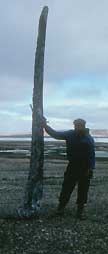
WHALE
MANDIBLE (JAW) |
Depending upon where you are in the Arctic, the wildlife can vary appreciably. The dynamics of the sea, the land and the seasons cause fluctuations in the diversity or propensity of certain species. A large ice-covered bay with plenty of basking seals will also be an area popular to polar bears. Ocean waters that remain ice free all or most of the year (polynyas) will attract whales such as narwhal and beluga. And for some strange reason, some areas of the Arctic will attract a certain range of bird life while another area with similar attributes will have a completely different representation of bird species. And then there is the muskox-caribou controversy.
In the nineteen teens, 20s and 30s, the Canadian federal government was concerned that American and Norwegian explorers and adventurers were over hunting muskoxen in the High Arctic. These adventurers were killing as many as a hundred muskoxen for food supplies and to provide trophies on a single expedition. In parts of the Arctic the muskox population was threatened with extirpation. In more recent years, the muskox has experienced a revival at the same time that caribou numbers have been dropping. It has been assumed that because there was a correlation that there was also a causal relationship: that is, muskox were winning the food procurement game over the caribou.

CARIBOU |
There are two major flaws with this assumption. It has not been proven that these two species, both herbivores, subsist on the same plants and therefore competing for food. And second, whereas muskox tend to have restrictive areas of roaming, caribou migrate over extensive areas. If the muskox were so plentiful that they were consuming all the food sources of the caribou, wouldn't they (the muskox) also be eating themselves to the brink of extinction.
Having been to numerous locations in the Arctic, the west coast of King William Island appears to be the most desolate place in all of Canada. In 1994 we saw one muskox, one caribou and one fox. In 1996 we saw one caribou, period, full stop. Yet along the southwest coast of KWI, only a few tens of miles away, we saw several caribou, seal, fox traps and fox, and tundra (whistling) swan that were not seen along the west coast of King William.
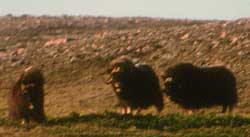
MUSK OXEN |
Meanwhile, on Victory Island, a mere 100 kilometre distance to the west, a muskox cull has to be conducted periodically to control the muskox population explosion. You can hike out of Cambridge Bay on a one hour trek and encounter herds of muskox that are not intimidated by humans due to there being a hunting prohibition.
Another significance difference between Victoria and King William Islands is the fish. On the western portion of KWI there are no freshwater fish, including the anadromous salmonoid fish that migrate between fresh and seawaters. Victoria Island, however, is noted for its sport fishing in its lakes and rivers. Yet these two islands are neighbours and share similar physiographic and geologic landscapes. To the immediate east of KWI, the western coastline of the Boothia Peninsula offers open waters during the summer season where char can easily be caught (yumm).
Although polar bears are commonly referred to as marine mammals, they will be included here with our discussion of land carnivores as they spend more time on solid surface than they do in the water. North of the Canadian mainland there are three species of carnivore: polar bear, arctic wolf and fox. Each has its own prey and response to human contact. On the mainland, there are also the brown bear grizzly and the wolverine.

ARCTIC FOX
WITH ARCTIC POPPIES
IN FOREGROUND |
Arctic fox are considerably smaller than the southern red fox. Not surprisingly, they tend to subsist on small food sources, such as bird eggs and lemmings. Arctic fox will nonchalantly trot into camp as if no one were home, act as if you didn't exist, and then trot off if no food is available to them. These fox normally travel alone roaming over fairly large areas.
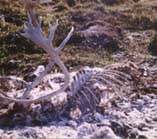
CARIBOU WOLF KILL |
Arctic wolves both act alone and in packs. If they are desperate they may eat lemmings, other small rodents, hares and even eggs during leaner times, but they primarily subsist off of lone or ailing caribou. Wolves are also the natural predator of muskoxen. When encountering an Arctic wolf, don't panic. They are likely more afraid of you than you are of them. Well, maybe not, but they won't stick around for long in order to find out if you are tooting a gun. If you encounter a pack of wolves, retreat slowly without showing signs of fear. You can change your underwear at a later time.

POLAR BEAR AT CAMP |
Polar bears primarily subsist on seals. They maintain a whitish fur year round unlike the other carnivores. Because polar bears are at the top of the food chain they naturally do not fear other animals, including humans. When encountering humans they can be either seeking food or just being curious. Luckily, the several times that I have encountered polar bears face to face, they were just curious. At these times, one can intimidate the bears and make them run away. If they consider you as a food source however, take appropriate precautions. Read up on encountering polar bears before you consider traveling in the Arctic without a qualified guide, or with. A curious bear can kill as easily as a hungry bear.
Birds of prey, also known as raptors, are numerous, but only a couple of species live year-round in the Arctic; these being the snowy owl and the gyrfalcon. Other raptors that use the Arctic as breeding grounds include the peregrine falcon and some hawks. These birds are capable of hunting rodents, hares and even new-born caribou. Although not considered raptors, birds such as ravens and jaegers are known to steal chicks from nests.
Numerous other bird species occupy the Arctic during the summer season. Gulls, terns, sandhill crane, shore birds, geese and numerous cliff dwellers frequent the various environments dependent on their specific needs. The one bird that will cause the most consternation for humans is the Arctic tern. These birds will relentlessly swoop down, making a tremendous ruckus, trying to peck your head even if you are innocently minding your own business. To avoid being pecked on the topside, hold something above yourself; at least the terns will attack this object instead of yourself.
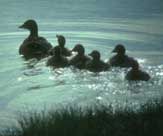
EIDER DUCK AND CHICKS |
As mentioned previously, numerous duck species gravitate to the Arctic to breed. One of the most known ducks in these parts is the eider, best known for its warm down, used for parka and sleeping bag insulation. The eider female will build its nest in a shallow hollow in the open terrain and because of its camouflage will be undetectable until you practically step on the nest, at which point the bird will burst out of its nest only a foot or two in front of you. At this point your heart will leap to your throat until you realize that you have been panic attacked by a duck that just catapulted away from what it considered imminent death.
Along the Arctic mainland coast there are also ground squirrels (siksiiq). The first time I saw one of these compact animals was at the Taloyoak airport, running across the airstrip. Larger than a squirrel and smaller than a ground hog, they are quite adept at speed and finding new homes. Like the grizzly bear that hunts them, they do not extend north of the Canadian mainland.
Although there are four subspecies of caribou native to Canada, only three are found in the Arctic: barren-ground, Grant and Peary. The Grant caribou are found in the extreme northwest corner of the Northwest Territories and westward. The barren-ground caribou are found on the north mainland and Baffin Island. Peary caribou cover the remainder of the archipelago islands. Wolves are their primary adversary.
What I refer to as the true marine mammals consist of whales and seals. Four species of whales find home in the Canadian Arctic: beluga, narwhal, bowhead (or baleen), and killer whale (orca). The beluga, narwhal and bowhead whales traditionally have been hunted by Inuit for a thousand years. The bowhead whale supplies oil, flesh and baleen, the latter of which can be used to manufacture numerous items, including mattresses and bows. Belugas and narwhal provided oil, flesh (muktuk) and ivory from the male narwhal tusk. The Thule, the ancestors of the Inuit, also used whale bone -amongst other materials- to construct their semi-subterranean homes. The formidable skull of the bowhead whale often formed the roof of the house entrance. Mandibles as long as four metres, as well as ribs, formed the frame work of the roof. Sections of stacked vertebrae were sometimes used to support stone slab sleeping platforms.
Seals and walrus were also a staple diet in certain areas of the Arctic. The Inuit around the Boothia Peninsula were known as the Netsilik, meaning "the people of the seal". They subsisted primarily on ring and bearded seal. Elsewhere in the Arctic, ring, harp, bearded and walrus were hunted dependent on the area or the season. It was primarily seal oil that was used as fuel in the traditional Inuit lamps (qudlik) that were used both for heat and light. Traditionally, the men hunted the seal and the women tended the seal oil lamp, keeping an even, smokeless flame.

MOSQUITOS |
No discussion of Arctic wildlife would be complete without some description of the mosquitoes. Nah, I'm not going to even try. You have to experience it to believe it. All I will say about the mosquitoes is they will teach you how to constantly breathe through your nose and not with your mouth.
There are other insect life present, including tiny spiders and large bumble bees. Even considering the variety and sometimes abundance of wildflowers, it is still surprising to see these stout black and yellow bees flying slowly over the terrain. In colder weather they almost seem to be flying in slow motion. One can only wonder how they survive the other ten months of the year when it is too cold for them to fly, mosquitoes included.
Climate
| As the Arctic warms and the amount of sea ice diminishes, polar bears are not able to capture the same number of basking seals as required to keep up their fat layers to survive the long winters. The edge of the tree line is shifting northward and with it, the red fox are displacing the arctic fox. Icebreakers have even recently come upon open waters at the north pole. What next, the Antarctic Ross Iceshelf breaking away? In the mid 1990s an environmental scientist contested that if the Ross Iceshelf ever split off from Antarctica, it would be the signal that it was too late to stop global warming. Whoops…too late! |
Cold, but getting warmer. Ahh, global warming to the rescue, or not. Remember those mosquitoes? The warmer the weather, the bigger and more plentiful the mosquitoes seem to get. As summers get longer, the breeding season also adds to the mosquito population. So what evidence is there that global warming is affecting the climate of the Arctic...?
Anecdotal evidence suggests that the Arctic is getting progressively warmer. Inuit are now applying sunscreen to protect themselves from sunburns. There was no need of sunscreen ten years ago. For several succeeding years we were greeted at the same community with the comment "this is the hottest summer on record". Hotter than the last summer when I wore shorts and a tee shirt for several days? "Oh yea, hotter." Yet one of our team wore his parka all the time, even when hiking. Nothing could convince him that the Arctic wasn't a frigid place.
But even scientists are concerned. As the Arctic warms and the amount of sea ice diminishes, polar bears are not able to capture the same number of basking seals as required to keep up their fat layers to survive the long winters. The edge of the tree line is shifting northward and with it, the red fox are displacing the arctic fox. Icebreakers have even recently come upon open waters at the north pole. What next, the Antarctic Ross Iceshelf breaking away? In the mid 1990s an environmental scientist contested that if the Ross Iceshelf ever split off from Antarctica, it would be the signal that it was too late to stop global warming. Whoops…too late!
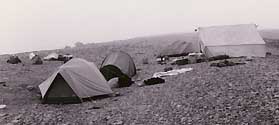
TENT CAMPING ON BOOTHIA PENNINSULA |
But even with global warming, Arctic summers can be uncomfortably cold. Not meaning that temperatures are below freezing, but that there can be vast fluctuations in the temperature and humidity. Even though the Arctic experiences semi-desert precipitation, the air can be quite moist. Fog is constantly being formed over open waters, then carried by winds to wherever any white guys are camping. When temperatures drop and humidity rises, the cold can eat through all the layers of clothing you can bundle yourself into. And then the next day you may be sweltering under dry sunny conditions accompanied by more mosquitoes than you thought imaginable.
One of the best times to travel in the Arctic is the spring season. Above the Arctic circle at this time of year, daylight may last eighteen hours, temperatures are -10 to -20 C and the air is dry. Even given the freezing temperatures, one must be conscious of not exerting oneself to the point of sweating. Sweat equals cold. Traditionally, dog sleds would have been the seasonal means of transportation. Today, snow mobiles transport humans and goods out on the land, but as is known in the north, snow mobiles can't find their way home in a blizzard, unlike the dog teams. Global positioning systems (GPS) have replaced the tracking senses of sled dogs.










